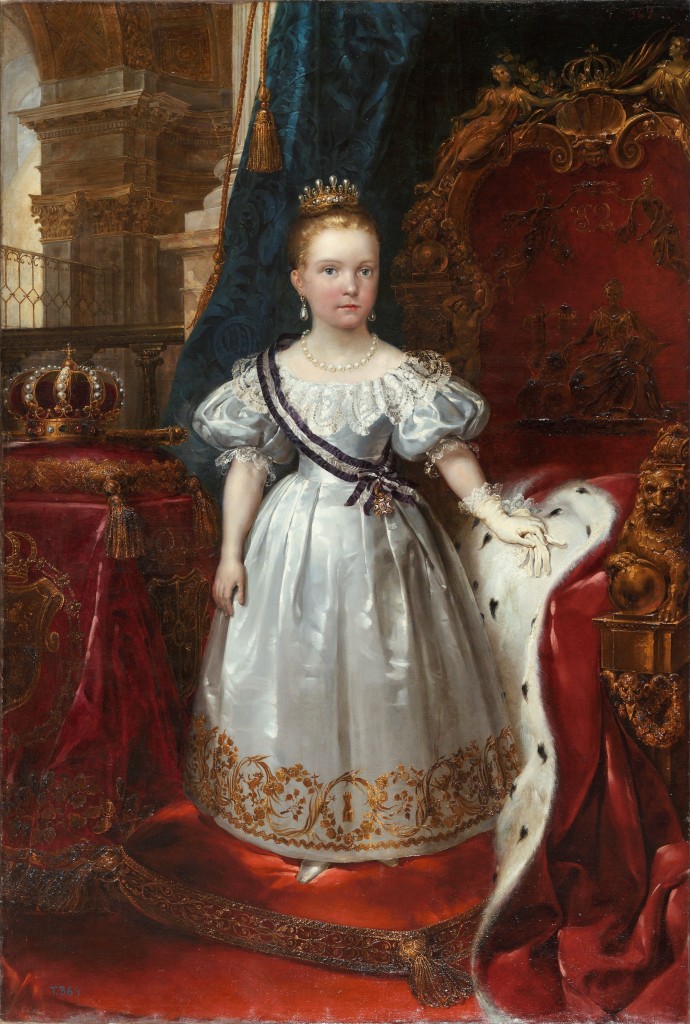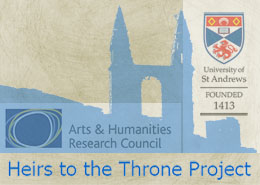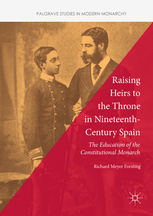See also: Niña de la libertad
A contested appointment: Juana de Vega and the education of Isabel II ![]()
Richard Meyer Forsting
On the evening of 7 October 1841 shots were fired at the Royal Palace of Madrid. Rebellious troops of the Madrid garrison attempted to force their way into the royal chambers to kidnap the young queen and her sister. Isabel and Luisa Fernanda, eleven and nine years old respectively, were terrified as bullets pierced their windows and the aggressors came ever closer. After an agonising and tense night of fighting, the courageous and vastly outnumbered Alabaderos who defended the entrance to the bedchamber, managed to repel the attack. Juana de Vega, Condesa de Espoz y Mina, was present at the side of the royal children, consoled them in their anxiety and afterwards documented the events in minute detail.
The attack was part of a wider conspiracy of moderate liberal elements against the Regency of General Espartero (1841-43). The moderates (moderados) among the officers and in the Cortes were dissatisfied with the shift in power in favour of their progressive liberal rivals (progresistas) which had occurred after the departure of the Queen Regent Maria Cristina into exile in October 1840. They singled out the appointment of progressive liberals to the court as particularly offensive. This was seen as a policy designed to undermine the authority of Maria Cristina, as both mother and head of her household. The kidnapping attempt was thus dressed up as an effort to free the girl queen from a hostile entourage. One particularly reviled figure at the centre of much of moderado criticism was Juana de Vega.
The outright snobbery of the highly traditional aristocratic Madrid court was certainly one of the reasons for this hostility. The appointment of the Countess in July 1841 as Aya to Isabel II led to the almost immediate resignation of her predecessor, the Marquesa de Santa Cruz, from her post as Camarera Mayor (First Lady of the Bedchamber). The post of Aya was of central importance in the upbringing of Isabel II, as it entailed vigilance over her lesson plan, an almost constant presence at the side of the royal children and the opportunity to influence the future queen directly. While the term is difficult to translate into English, one could think of it as a form of personal tutor for heirs or rulers in waiting. The post was highly prestigious and it was traditionally only bestowed on the highest ranking members of the Spanish nobility. The Marquesa de Santa Cruz, who had held both the post of Camarera Mayor and Aya, was a perfect example of this. Not only was she a close confidante of Maria Cristina but also a member of one of the most distinguished aristocratic families and a Grandee of Spain.
Following Santa Cruz’s lead many of the other ladies in the service of Isabel and her sister also handed in their resignations. As the Marquesa wrote in a letter to Maria Cristina; ‘walking behind that Mina woman was truly too cruel’ for many of the aristocratic ladies. They had suffered a lot since the departure of the queen regent but this appointment was the final straw.[1] Even Maria Cristina’s exhortations to Santa Cruz and the other ladies to stay on as her informants and prevent pernicious influences on her daughters could not stop them from resigning. The issue of Juana de Vega’s common birth in combination with her being placed above them in the hierarchy of the court seemed utterly offensive.
Unlike most of the court, the new Aya was from an upper middle class background, typical of the emerging bourgeoisie in Spain, with no prior links to the court. Juana de Vega was born into an Andalusian merchant family as an only child. Her father had been politically active during the War of Independence and after the return of Ferdinand VII had joined the 1815 rebellion of Polier against the re-establishment of absolutist government. It seems that her parents encouraged young Juana to write and study beyond what was expected of women at the time. After the failed uprising in 1830 the family went into exile in Great Britain and only returned to Spain during the brief return to constitutionalism known as the Trienio Liberal (1820-23).
Juana’s second stint in British exile was spent at the side of the famous liberal general Francisco de Espoz y Mina (1781-1836), whom she married in 1821. Juan Pérez de Guzmán has argued that her experience of the British system strengthened and deepened Juana’s faith in constitutionalism, while preserving a strong monarchical sentiment. In 1833, after the death of Ferdinand VII and another unsuccessful rebellion of Francisco de Espoz y Mina only three years earlier, the couple returned to Spain for good. Following the death of her husband in 1836, Juana dedicated herself almost entirely to writing and editing his memoirs until she was appointed as Aya to Isabel II. It is hardly surprising that this child from a bourgeois background, wife of a famous progressive general and a progressive liberal was not welcomed warmly at court.
Rather than being just a personal issue, the controversy over the new Aya was part of a much wider debate over the limits of parliamentary authority and royal prerogatives. The man behind Juana’s appointment, Agustín Argüelles was elected as Tutor, a term best translated as ‘guardian’, by the Cortes in 1841. While many moderados were deeply uneasy about his progressive credentials and his history of opposing Ferdinand VII, they were even more concerned by the fact that the appointment of the Tutor was in the hands of the chamber in the first place.
As Encarna and Carmen García Monerris have argued, the absence of the queen regent opened up debates over what was to be considered private or public affairs, in particular with relation to the monarchy.[2] The moderados argued that the authority to decide on matters concerning the upbringing of Isabel II lay with her mother, the queen regent, despite her absence. They regarded the question as a private family matter, which the deputies had no right to interfere with.
The progresistas on the other hand argued that Maria Cristina had given up all her prerogatives and believed that the education of the future ruler was not a private issue at all but one of national importance. The education of the queen was explicitly linked to the destinies of the nation and acquired the utmost importance. This was believed to justify the involvement of the Cortes in determining its direction. The progresistas were determined to surround the queen with liberal and constitutional ideas in the spirit of the 1812 constitution, as Martín de los Heros, liberal deputy to the Cortes and Intendente de Palacio during the Espartero regency made clear. He stated that the aim was to identify both the dynasty with the nation and the monarchy with progressivism by ‘making courtiers liberals and liberals courtiers.’[3]
Juana de Vega clearly shared the belief that the upbringing of Isabel II was a matter of national importance and public interest. Her initial response to her appointment reveals certain reservations about accepting the post, in particular doubts about her own qualifications and the anticipation that traditional sectors of the court would be hostile to her.[4] However, she was convinced by Argüelles, who argued that the upbringing of Isabel II and Luisa Fernanda was a matter of the utmost importance to the future of the Spanish nation. This closely echoed the arguments previously made in the Cortes. Argüelles insisted that Vega’s reservations had to be overcome, as ‘all considerations have to cede before the good of the Patria’.[5] In her memoir Juana de Vega described her final acceptance as a sacrifice to these demands and needs of the nation. To her the education and upbringing of Isabel was not a private but a public and political matter. She linked the queen’s education to the destiny of the patria and makes the association of service at the palace as service and sacrifice to the nation explicit. Thus Mina identified quite explicitly with the progresista position and their aim of educating Isabel to become a liberal queen.
This view was radically different from that of the traditional elements at court. They interpreted their duty not as a service to the nation but as a personal service to the monarch to whom they had sworn their allegiance. Santa Cruz also used the language of sacrifice in her correspondence with Maria Cristina, but her sacrifice was a personal one to the queen regent, not to the wider nation. She was willing to give up her political misgivings as a matter of loyalty to the monarchy. Much of the same is true for those ladies that eventually felt compelled to resign from their positions at court and those that were later implicated in the conspiracy of October 1841. It became clear at that point that some members of the court had been involved in planning and providing information to opposition forces. Their aim was to restore what they believed to be the rightful authority of Maria Cristina over the upbringing of her daughter.
As these arguments over the reach of parliamentary authority intensified and the progressives used their parliamentary majority to push through reforms, the moderados regrouped and planned to overthrow Espartero. As the initial rebellion, which started in Pamplona, was fading out, the central aim of the moderado plan to win power focused on gaining control over the palace and the royal offspring. The Madrid garrison decided to seize the moment and attack the palace. Their failure to overcome a relatively small force of soldiers in the palace and their decision to put the lives of the young queen in jeopardy discredited the rebellion, which ended in abject failure. Nevertheless, according to Mina, that night left a lasting impression on Isabel and her sister, who were both terrified by the incident and fascinated by the heroism of the troops defending their quarters.
The account of the night in Mina’s memoirs gives us a good insight into the anxiety and panic that broke out at the palace. One of the most critical moments came at two in the morning, when ‘a bullet pierced the window of the Theatre Salon and shattered the glass.’ No one was injured but Mina reported that ‘the Ladies [Isabel and Luisa Fernanda] were highly exposed, and any incident would have been capable of augmenting the confusion and distress reigning among us.’[6] For the first time Isabel and her sister were directly and violently confronted with the political conflicts that were coming to the fore during the Espartero Regency.

Portrait of the 18 Alabaderos, led by Coronel Dulce, who defended the Palace on 7 October 1841 (Congreso de los Diputados, c.1842)
The progresistas unsurprisingly condemned the attack on the palace as a cowardly and irresponsible act. The justification of the attack by the moderados relied almost entirely on the argument that the queen was surrounded and held captive by a progressive, illegitimately appointed entourage. This allowed the aggressors to portray their actions not as a kidnapping but as an attempt of setting the queen free and restoring her mother’s rights over her education. Juana de Vega, who was with the terrified children throughout the events, played a key role in these debates and emerged as one of the focal points of moderado criticism.
Even after the failure of the October 1841 conspiracy, the Condessa de Espoz y Mina would remain in the public eye and was subjected to harsh attacks in the opposition papers, especially after she was made a Grandee of Spain and Camarera Mayor in October 1842. Throughout her time as Aya, Juana de Vega defended herself against these criticisms and tried to imbue the queen with a liberal spirit and bring her closer to the people. Unlike her predecessor she would take Isabel out on semi-public walks more frequently and constantly reminded her of her constitutional duties. Her responsibility as Aya did not directly include teaching but it did involve the supervision of lessons and what she calls ‘moral and political education’. In practice this meant Espoz y Mina would usually assist the teacher during lessons to make sure that they were applying themselves and that they were paying attention, as well as directly clarifying and explaining political issues when she thought it appropriate. Together with the director of teaching, she sought to introduce an education in constitutional politics so ‘that the thoughts, the habits and customs of Isabel II shall correspond to those of a queen of a free people’.[7] As it turned out her time at the palace – along with the progressive dominance in politics as well as at court – were cut short by the success of the yet another rebellion against Espartero in July 1843. Not even a year later, Isabel’s minority ended when, at just thirteen years, of age she swore an oath on the new constitution in 1844.
Further Reading:
- Espoz y Mina, Juana María de la Vega, and Juan Pérez de Guzmán, Apuntes para la historia del tiempo en que ocupó los destinos de aya de S.M.Y.A. y camarera mayor de palacio (Madrid: M.G. Hernández, 1910)
- Burdiel, Isabel, Isabel II : una biografía (1830-1904) (Madrid: Taurus, 2010)
- Burdiel, Isabel, and María Cruz Romeo, ‘Old and New Liberalism: The Making of the Liberal Revolution, 1808-1844’, Bulletin of Hispanic Studies 75 (1998), 65–80
[1] Archivo Historico Nacional, Madrid, Diversos Titulos Familias, Leg. 3519, Libro 48, Doc. 90, Letter of Santa Cruz to Maria Cristina, 07/08/1841
[2] Encaran García Monerris and Carmen García Monerris “?Interés de familia u objeto politico? La tesamentaría de Fernando VII” in García Monerris, Encarnación, Mónica Moreno Seco, and Juan Ignacio Marcuello Benedicto (eds), Culturas políticas monárquicas en la España liberal: discursos, representaciones y prácticas, 1808-1902, 2013, 171-211, 190-91
[3] Diario de Sesiones de Cortes, 13 April 1855, 3730
[4] Juana María de Vega Espoz y Mina and Juan Pérez de Guzmán, Apuntes para la historia del tiempo en que ocupó los destinos de aya de S.M.Y.A. y camarera mayor de palacio (Madrid: M.G. Hernández, 1910).
[5] Letter of Argüelles to Juana de Vega, Condesa de Espoz y Mina 21 July 1841, cited in Ibid.
[6] Juana María de Vega Espoz y Mina and Juan Pérez de Guzmán, Apuntes para la historia del tiempo en que ocupó los destinos de aya de S.M.Y.A. y camarera mayor de palacio (Madrid: M.G. Hernández, 1910), 71
[7] Archivo Historico Nacional, Madrid, Diversos Titulos Familias, Leg. 3757, N.5. ‘Exposition of the Ayos of H.M. and H. to the Tutor on the studies of the Ladies’, 20/05/1843







